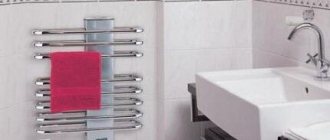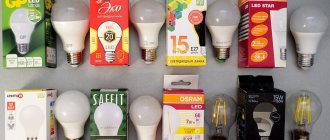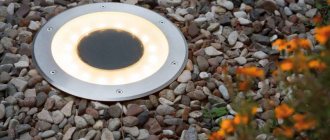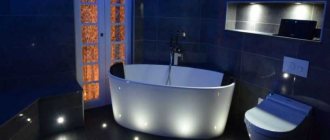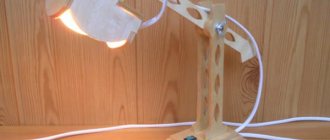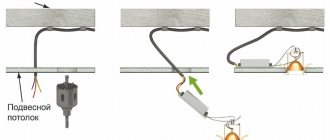Bathroom fixtures must meet special requirements since they are located in a damp area. Lighting fixtures of this type are always designed as a closed structure to prevent water from penetrating the electrical contacts.
There are many models of waterproof lamps, and in order to make the right choice when purchasing, you need to understand the nuances of this type of device.
The difference between waterproof lighting fixtures and conventional ones
At first glance, it is difficult to distinguish moisture-resistant devices from ordinary ones. The main differences lie not in the appearance of different types of devices, but in their internal details. Moisture-resistant lamps are equipped with additional elements, the main task of which is to protect the socket, terminals and electronic unit from moisture penetration.
Under no circumstances should water get inside the lampshade. Therefore, the first factor that you need to pay attention to when purchasing is the presence of sealing rubber at the joints between the lampshade and other parts of the device. It is also necessary to have special waterproof plugs located at the wiring input into the housing.
Moisture resistance is a quality that is not characteristic of ordinary lamps. Therefore, resistance to moisture is always indicated in the accompanying documentation (technical data sheet), as well as on the packaging.
Light level
In the bathroom, people perform two types of activities:
- Relax by taking relaxing water treatments.
- They go about their business - wash, apply makeup, shave, do laundry, and so on.
In the first case, it is advisable to use dim lighting, which allows you to create an appropriate atmosphere and escape from all worries. For this purpose, you can install floor spotlights or LED strip of a suitable color. If this is not possible, then simply use low-power light bulbs.
In the second case (to perform work), bright lighting without sharp shadows is necessary. To make it comfortable to perform any actions in the bathroom without damaging your eyesight, it is important to know how much power different types of lamps have. Here are the standards per 1 m2:
- LED – 6-9 V;
- halogen - 23-28 V;
- incandescent lamps - 20-30 V.
As you can see, the last option is the most cost-effective. The photo below shows additional characteristics of the lamps. They need to be taken into account when purchasing this product.
Types of waterproof lamps
Waterproof equipment is usually divided into different types depending on the installation location, installation method and type of light bulbs. Each type of lamp has both pros and cons. Therefore, it is impossible to single out any type of lighting fixture as the best.
Lamp location
There are three types of devices - wall-mounted, ceiling-mounted and floor-mounted. Usually they try to install the first two, much less often they are placed on the floor. The main reason for this is that bathrooms are rarely large enough to accommodate a floor lamp. It is the lack of space that dictates the need to install all kinds of interior details in niches, suspended ceilings, under the sink or bathtub.
Mounting method
According to this feature, lamps are divided into three types:
- Built-in (mortise). Installed on the ceiling, in walls or floors, in furniture or any other interior items. They are characterized by a significant variety of dimensions and shapes. At the same time, they are the simplest in design: they are a housing equipped with clamps.
- Overlays (external). Such devices are placed on solid foundations. External models are popular in cases where it is impossible to install a mounting niche (for example, when it comes to a concrete ceiling). Also, overhead devices are used if the lighting device is used not only for its intended purpose, but also as decoration. There are many variations in execution: from the most unremarkable to the most exquisite. Based on their location, overhead devices are divided into ceiling-mounted and wall-mounted.
- Hanging. This type of lamps is the least used. Such devices are suspended from a ceiling mount. In this case, the device is not located flush with the ceiling, but at a certain distance. For fixation, hooks, hangers, or even a power cable are used. Any ceiling is suitable, including slatted, suspended ceiling, concrete, and plasterboard. The main condition is that the ceiling height must be sufficient for mounting the lamp. Suspended models are also available for wall mounting and are mounted on adjustable brackets.
Bulb type
The brightness of the light and energy consumption depend on the type of lamp installed in the lamp. Most lamps are suitable for any type of light bulb, so the choice of a specific type depends on the preferences of the residents.
| Type of light bulb | Technical features |
| Luminescent | Characterized by low power consumption and long service life. The light spectrum practically corresponds to daylight. Light output is higher compared to incandescent light bulbs. The disadvantages of fluorescent light sources are damage due to voltage surges, high prices for lamps and a delay in warming up |
| Incandescent lamps | This type is resistant to temperature changes and power surges. There are light bulbs on sale with a matte coating, the light from which spreads more evenly and does not give a glare effect. For the bathroom, you should choose lamps in the power range from 15 to 40 W. The disadvantage of this type of device: the light bulbs are prone to severe overheating, which leads to the melting of the housing made of plastic |
| Halogen | This type of lamp produces a directional beam of light and is typically used for recessed lighting. Halogen light bulbs are characterized by increased luminous efficiency, long service life, and compactness. Disadvantages of halogen lamps: rapid overheating, responsiveness to power surges, sensitivity to the appearance of grease stains on the surface. The last disadvantage entails the need to use gloves or wipes when handling these light sources |
| LED | Diode bulbs operate from a low-voltage power supply and are therefore absolutely safe. LEDs do not overheat, use energy sparingly, and provide good light output. Their service life is longer compared to any other types of light sources. They have LEDs and a significant drawback - high cost |
What to choose and in what case
When choosing lamps for the bathroom, it is recommended to follow these practical recommendations:
- the design must have a protection class of at least IP44;
- spot ceiling lighting consumes less electricity;
- LED and fluorescent lamps have the longest service life;
- To highlight individual functional areas, you can use sources with directional light flux.
Note! The lighting technology market is overflowing with cheap Chinese products. Often these products have inadequate sealing, poor quality assembly, low luminous flux and a host of other shortcomings. Therefore, if financially possible, it is recommended to give preference to high-quality lighting equipment from well-known brands.
Protection of lamps
The security of light sources is determined according to a special security index. It is a European standard where protection ratings are indicated by a pair of numbers and letters (for example, IP44). The letters are an abbreviation for Index of Protection. The first digit indicates the degree of protection against the penetration of solid dust particles into the device, and the second - protection against the ingress of liquids (including aggressive ones).
For some device models, a third digit is provided, indicating the degree of shock resistance of the device. However, for bathrooms the third number is unimportant, and the first two are decisive. It is the moisture resistance and ability to resist dust that determines whether the installation of a particular lamp model is suitable for the bathroom.
IP protection indices
The tables list the characteristics corresponding to a particular class of protection against dust or moisture specified in the IP.
Compliance with dust protection classes is shown in the first table:
| Index indicator | Characteristics |
| 0 | Lack of any protection |
| 1 | The lamp is protected from large solid elements smaller than 5 centimeters in size from entering the housing |
| 2 | The lighting device is protected from contact with objects whose size exceeds 12 millimeters |
| 3 | The device is protected from penetration by elements larger than 2.5 millimeters |
| 4 | Any particles larger than 1 millimeter are not dangerous. |
| 5 | The device is protected from the ingress of dust that could affect the performance of the lamp |
| 6 | The maximum achievable degree of protection of the luminaire from dust contamination |
The following table shows the moisture protection classes:
| Index indicator | Characteristics |
| 0 | No protection from moisture |
| 1 | The lamp is protected from water drops falling onto the device vertically. Protection only against condensed moisture is possible |
| 2 | The lighting device resists particles hitting it at an angle of up to 15 degrees relative to the vertical |
| 3 | There is protection against drops falling on the lamp at an angle of up to 60 degrees |
| 4 | The device is reliably protected from water penetrating from any side and at any angle. |
| 5 | Protection not only from drops, but also from water jets |
| 6 | Ability to work in seawater conditions |
| 7 | The device operates under fluid pressure conditions. This protection class is required when immersed under water to a depth of 1 meter |
| 8 | The lamp operates at great depths |
Humidity zones
Bathrooms are usually classified into zones according to the degree of exposure to moisture on lighting fixtures. The choice of luminaire should be correlated with the humidity zone in which it is installed:
- First zone. It is the wettest area in the bathroom. The level reaches 100%. The first zone includes the bath itself, as well as the interior space of the shower stall. In this area, it is allowed to install only light bulbs that operate on low voltage (12 Volts). For this area, luminaires with a degree of protection of at least IP67 are recommended.
- Second zone. This includes walls up to a height of 2.25 meters from the end of the bathtub. Luminaires must be protected from steam, splashes and accidental exposure to water jets. IP45 protection index is recommended. Allowable voltage: within 12-24 Volts.
- Third zone. Extends 60 centimeters from the border with the second zone. Here the luminaires are usually not directly exposed to water, but must be protected from condensation. The minimum level of protection is IP24.
- Fourth zone. This zone includes all other space that does not fall into the first three zones. The recommended protection index is one or more for steam.
Mistake 7. Buy a chandelier/sconce with a dark shade and pattern
The material of the lampshade or floral shades can eat up the light power and convey the color of the light incorrectly. For example, a lampshade made of dark, light-retaining material reduces the level of illumination, which is most inconvenient in the bathroom, while many decorative details leave a shadow. Therefore, check immediately in the store how overly designer and decorative models transmit light.
Unsuccessful sconce for the bathroom, photo example
A successful example of a sconce for a bathroom, photo example
Primary requirements
Requirements for lamps installed in the bathroom are usually divided into three groups: safety, brightness, design.
Safety
Since the bathroom is characterized by high humidity, electrical wiring must be completely protected. Lamps with a completely closed sealed housing are allowed. The device must be at a safe distance from water. According to GOST, this distance is at least 50 centimeters.
Brightness
The level of illumination in the room needs to be comfortable for humans. Cosmetic procedures are carried out in the bathroom (for example, applying masks or shaving), and therefore the light should be bright enough.
Light bulb power standards (W per square meter):
- light diodes (LED lamps) - from 6 to 9;
- incandescent lamps - from 20 to 30;
- halogen bulbs - from 23 to 28.
Advice! If the bathroom has a dark finish, it is recommended to choose more powerful light bulbs.
Design
A number of recommendations relate to the design of lighting fixtures. There is a wide variety of lamps on sale in different styles. The most popular solutions are:
- Classic style. The interior, made in a classic style, is associated with the use of natural materials (stone, wood, leather). This style is suitable for both a ceiling lamp (for example, a chandelier) and a wall lamp (for example, a sconce or spot). Classic solutions also include the use of forged products and crystal and bronze elements.
- Japanese style. The solution is distinguished by external calm and tranquility. The light from lighting fixtures is soft, slightly diffused. The shape of the lamps is often unusual, replete with complex outlines.
- Modern style. All design elements have some function. There are no parts that are useless from a practical point of view. Modern is more suitable when zonal rather than central lighting is organized. LED lighting is often used in this style.
- Provence style. This style requires the presence of a window in the bathroom. To organize sufficiently high-quality lighting, large chandeliers or floor lamps are used. Moreover, the light sources should resemble plants in their shape or finish. All forms are characterized by free lines, without geometric regularity.
Note! Plastic and glass products are more preferable than metal, as they are not subject to corrosive processes.
General lighting
This type of lighting should provide uniform illumination of the entire room.
As a rule, bathroom ceiling lights are used for these purposes. They provide the necessary level of light, scattering it throughout the space.
The best manufacturers
The most popular products from the following companies:
- Downlight Lug. The Polish company primarily produces lamps for bathrooms. Waterproof and impact-resistant products are equipped with specially shaped housings and lampshades, thereby preventing excessive light scattering. The devices allow you to redirect the light flux in the desired direction, which is convenient for zoning the room. There are several lines of this Polish manufacturer, including Vandallug, Diamond and Star Premium lamps.
- Massive (Belgium). The products of the Belgian manufacturer belong to the upper price category and are of high quality. Lamps of various protection classes are produced. Some products are designed to work in saunas or baths, and not just bathrooms. The range includes both ceiling and wall lamps. The company has several product lines that differ in style: Aqua Oasis, Katie and Adrio.
- Eglo (Austria). The products are characterized by a unique design: the lamps are made in curved shapes with soft outlines. Lampshades are usually plated with chromium or nickel, since these metals protect the base material from oxidation. Some products are made of plastic and covered with fiberglass for greater durability. The company's product range includes wall and ceiling lamps. Among the brands worth noting are Palmera and Mono.
- Arte Lamp (Italy). The products of the Italian company are distinguished by high quality, bold design and long service life. Product lines: Hall, Aqua.
- Kanlux (Poland). The company produces both built-in and hanging lamps (ceiling and wall). The scattering elements are made of metal with polymer inserts. The fasteners are made of stainless steel. Pendant light housings are usually polyester or fiberglass. Of all the listed manufacturers, Kanlux produces the most affordable products. The most popular brands are Volin, Argus (with switch), Turk.
Work lighting
Almost every bathroom, even the most compact one, has at least one work place - this is the area near the mirror. It must be equipped with additional lighting fixtures in order to guarantee the comfort of performing hygienic and cosmetic procedures.
To illuminate the mirror, you should use a device with bright light, but not giving excessively harsh shadow effects.
Here you can use the following types of bathroom fixtures:
- sconce;
- directional radiation devices;
- lighting integrated into the mirror;
- desk lamp;
- hanging fixtures;
- floor lamps
Tips for choosing a lamp
To choose a suitable lamp for the bathroom, it is recommended to adhere to a number of rules:
- The degree of protection of the device is IP55 or more.
- Use spot lighting whenever possible. This reduces energy consumption, and the luminous flux becomes more accentuated.
- If it is not possible to install spotlights for some reason, it is recommended to install directional lighting bulbs. They allow you to create high-quality lighting in given areas (for example, you can install a lamp above a mirror so that it illuminates only the area near the washbasin).
- The best lamp option is a 12-volt product. It does not pose a threat to human life and health. However, in this case you will have to buy a step-down transformer.
- If it is not possible to run wires, it is recommended to use wireless lamps. They are battery powered and are just as safe as 12 volt ones. A wireless device is usually used as a remote light source.
If you wish, you can save money and connect the lamp yourself. At the same time, you should not get carried away by the cheapness of products from some manufacturers. It is better to choose a product that is more expensive, but from a European company that has long established itself. Chinese ones most often do not meet the requirements for quality products. Such products can be unsafe, which is unacceptable when it comes to lighting equipment for the bathroom.
Installation locations
Light should not just reach, but flood every area of the room. At the same time, try not to point the lamps at reflective surfaces.
A common mistake is to install a single lamp above a mirror.
With this arrangement, the reflection in the mirror will be distorted. Therefore, it is better to place light sources on the sides.
At the same time, they should not give multi-colored highlights or shine with different intensities (make sure the lampshades are clean), and even better if they have matte diffusers.
It is advisable to place rotating spots above the mirror rather than stationary ones.
If there are several lighting zones, lay separate wiring under them with connections from two and three-key switches.
In this simple way you can easily adjust the light intensity.
You can also initially establish a connection via dimmers.
Do not place ceiling lamps close to the wall. Place them as close to the center of the room as possible.
Otherwise, they will subsequently clearly demonstrate all the smallest imperfections and uneven finishes.
LED strips
LED lighting is one of the newest lighting methods. LEDs are capable of producing bright white or colored light, they last a very long time, consume minimal electricity and do not heat up. This allows you to use this type of lighting to illuminate suspended ceilings, mirrors, shelves and niches.
LED strip is often used for additional room lighting. For example, if necessary, you can turn on and off the diode illumination of the mirror, and another lamp can provide general light.
If you place a diode strip behind a mirror, it will be picturesquely illuminated and seem to float in the air.
LED cabinet lighting makes the bathroom visually larger.
LEDs have another undeniable advantage over other types of lamps; there are special LED strips that are not afraid of not only drops, but even jets of water. The LED strip is very easy to install; just remove the protective coating and stick it on.
Bathroom sconce - what to look for before buying?
A bathroom sconce is a product that differs in many ways from the models installed in the hallway, living room or bedroom. Bathroom lighting must meet additional criteria - be resistant to moisture, provide an optimal level of light, and also be harmoniously combined with other equipment and interior items.
Aesthetic considerations are very important - the wall lamp must match the design of the bathroom and at the same time be easy to clean, resistant to corrosion and other factors that could negatively affect its appearance.
It is also worth remembering that the light should be gentle, diffused and imitate natural as much as possible.
It should also not be placed in such a way that shadows appear on the face. If you pay attention to these small but important details before purchasing a wall lamp and you will definitely be satisfied with the effect, your makeup will be flawless.
Light temperature
It has been scientifically proven that neutral light is the most comfortable for the eyes. This color is obtained between classic warm yellow and cool white light. Neutral light is most similar to sunlight and does not distort the colors of the objects around us.
When choosing a bathroom lamp, be sure to check with the seller whether it can be used in a damp environment. Special moisture-resistant luminaires usually have a thicker layer of insulation to protect the fixture from short circuits.
We install sconces with our own hands
Installation of a lighting device includes several successive steps. In this case, the presence of electrical wiring will greatly simplify the task. However, any person with basic knowledge of the operation of electrical appliances and basic skill in using special tools will be able to handle the installation without much effort.
First of all, it is necessary to outline the optimal location of the light source. It is recommended to bring it as close as possible to the hidden wire. Then holes for fastenings are drilled on the finished markings. It's worth being careful here. Next, plastic bases are inserted into the recesses and a bracket with self-tapping screws is attached. During the installation process, it is worth removing the lampshade from the sconce to avoid unintentional damage. The lamp is then connected to the electrical wiring. Finally, the sconce is placed on the bracket and secured with special screws. Installation completed successfully!
All you need to remember is the basic safety rules, which state that before carrying out work on installing electrical appliances, the wiring must be de-energized.
Sconce is an excellent choice of lamp that has not lost its relevance for many centuries! Convenient to use, compact when placed and an original item when organizing a lighting system - all these are wall sconces!



